| |
|
Oviraptorosauria
- "The Egg Snatchers" |
Oviraptors are some of the
strangest-looking theropods. They were a very rare group of
maniraptorans that are well represented by excellent fossil from the
Cretaceous period of Mongolia and North America which were connected,
as the supercontinent Laurasia the Cretaceous period. Some of
the most well-preserved specimens of dinosaurs ever found are
oviraptors. Oviraptors were once considered to be ornithomimid
dinosaurs, but are now placed within the clade Maniraptora.
They ranged in size from small to moderately large. All were
bipedal and ran on the hind legs. Their most distinguishing
characteristic us a toothless jaw which formed a massive beak. Their
jaws were well-muscled and adept at crushing. They are distinguished
from the toothless ornithomimosaurs by the development of a massive
beak and the highly specific in configuration and structure of the
lower jaw with the characteristic articular joint.
The skull provides hints at their possible lifestyle. They
were definitely not carnivores as they had no teeth no cut meat and
they were probably not herbivores, but they may have eaten mollusks
such as clams that lived in the water nearby.
The name "oviraptor" (egg snatcher) is a misnomer; their jaws
are not useful for eating eggs, but for crushing very hard food.
Oviraptors were originally thought to eat eggs because a skeleton was
found near a nest that was presumed to be that of the ubiquitous
Protoceratops, a ceratopsian dinosaur. A recent discovery found an
oviraptor embryo inside one of those eggs, so actually the oviraptor
was by its own nest. More expeditions have found oviraptor
skeletons on top of nests. These devoted parents apparently died
in sudden sandstorms while guarding their nests. Just recently, one
of the most amazing fossils ever found was announced - an Oviraptor
skeleton preserved brooding a clutch of eggs, just like a bird does.
This provides excellent evidence of bird-like behavior already present
in the close relatives of birds, and hints that these animals may have
been endothermic (brooding keeps eggs warm). |
 |
Caudipteryx zoui -
140 MYA
Liaoning Province, China.
3 feet long
Caudipteryx was a turkey-sized dinosaur. It had short
forelimbs, large eyes and long, sharp, spiked teeth. Quick and agile,
it had long slender legs. The most prominent feature of Caudipteryx had to be its tail, which
was covered with 6-inch-long tail feathers. The feather fossils show
bands of dark and light that may have been color, giving us an idea of
how Caudipteryx looked. It was unable to fly.
|
|
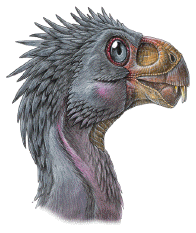 |
Incisivosaurus gauthieri
- 120 MYA
Unlike the other oviraptors,
Incisivosaurus had a mouth full of
teeth. At the
very front of the mouth was a pair of enormous gnawing incisors,
similar to the “buckteeth” found in mice and beavers. These bizarre
teeth have given rise to countless absurd descriptions of Incisivosaurus, from “the bucktoothed oviraptorid” to “the rabbitosaurus”. |
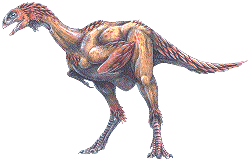 |
Avimimus portentosus - 95 MYA
Mongolia, China. 5 feet long
Avimimus
looked so much like a bird that its name literally means that it
imitates a bird. It looks like a large reptilian roadrunner.
Small ridges on its forearm that could be anchor points for
feather shafts. Since it descended from Caudipteryx,
scientists have concluded that it had feathers too. |
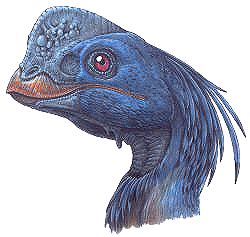 |
Chirostenotes pergracilis
- 70 MYA
Alberta Province, Canada - 6 feet long
This little dinosaur was primarily a carnivore, but may have
been omnivorous to some extent. The diet of Chirostenotes largely
consisted of small game such as lizards and fish. It may have also
eaten eggs. |
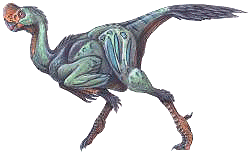 |
Rinchens mongoliensis
- 70 MYA
Mongolia, China - 8 feet long
Rinchenia had the tallest head crest of any oviraptorid. In
recent studies of Oviraptors, it appears that each individual
would have had a different crest shape and size. North American
members of this family discovered to date are considerably larger
than their Asian cousins. |
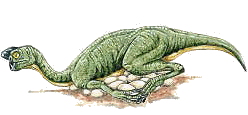 |
Nomingia gobiensis
- 68 MYA
Gobi Desert - 3 feet long.
This 1995 discovery was extremely important as Nomingia
is the first classic dinosaur known to have
possessed a pygostyle, a bone long considered unique to birds. This little dinosaur was just about ready to fly! Well, it was at least
on its way to becoming a bird. Nomingia is a good example of
the term "missing link". |
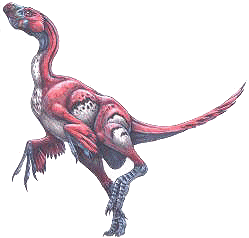 |
Oviraptor philocerataops
- 67 MYA |
| |
Other Speices |
| |
Microvenator celer Ostrom, 1970
Microvenator is based on a partial postcranial skeleton
discovered in the 1930s that was originally associated with large
teeth.Thinking these teeth belonged to the skeleton, Barnum
Brown informally named the specimen "Megadontosaurus".
The teeth later turned out to belong to a larger theropod,
Deinonychus, and the skeleton, named Microvenator,
is now known to belong to a small basal relative of the
oviraptorids of Montana |
| |
Omnivoropteryx
sinousaorum Czerkas and Ji, 2002
mid Barremian-early Aptian (EK) of China
Well...it seems to be a possibly flying critter with a
Caudipteryx-like head. It's known from most of a skeleton,
found with possible remains of
Cryptovolans, another possible flyer, this time a
dromaeosaurid. The animal, as the name suggests, is interpreted
as an omnivore, based on the skull. |
| |
"Thecospondylus"
daviesi (N.D.) Seeley, 1888
Barremian (EK) of England
Also known as Thecocoelurus, this taxon, based on a
cervical, does not pertain to the much larger
Thecospondylus, but instead appears to be an
oviraptorosaurian, possibly related to the caenagnathids. It was
rather large, on the order of 7 meters long. |
| |
Heyuannia huangi
Lu, 2002
Maastrichtian (LK) of China
Known from multiple remains from at least five individuals, this
animal inspired some interesting press in dinosaur paleo circles a
while back when it was suggested that reproductive organs were
preserved with one individual. It seems to be rather large for an
oviraptorid, and the type is an excellent partially-articulated
skeleton with a partial skull. |
| |
Citipati osmolskae Clark, Norell, and Barsbold, 2001
early Campanian (LK) of Mongolia
Citipati is another new oviraptorid based on good remains,
a skeleton and skull; remains from two other individuals are
known.
Possibly referable to this genus is specimen GI (SPS) 100/42, an
excellent specimen (known for its crested skull) previously
referred to Oviraptor, and the subject of most current
restorations of "Oviraptor", including those in Gregory
Paul's Predatory Dinosaurs of the World. |
| |
Nemegtia barsboldi Lü, Tomida, Azuma, Dong, and Lee, 2004
early Maastrichtian (LK) of Mongolia
Described as closest to Citipati osmolskae, this genus is
based on at least a skull with a prominent crest that has a nearly
vertical rostral margin which is at about a 90-degree angle to the
dorsal margin of the skull (this confuses me a bit; if I had to
guess, this refers to the skull roof, as otherwise they would have
said crest again. However, this is somewhat self-evident, because
a subvertical anterior margin has to be defined as such against
some sort of reference). As you might guess from the name, it
comes from the Nemegt
Formation. |
| |
"Ingenia" yanshini
Barsbold, 1981
early Campanian-early Maastrichtian (LK) of Mongolia
The most unusual feature of this animal is its hands. It has
three clawed fingers, but unlike almost all other theropods, the
digits are approximately the same length, with the first as
longest, another unique feature. It was weakly crested, with a
low triangle on the snout end.
Recently, it was discovered that Ingenia was preoccupied by
a nematode (Gerlach, 1957); a replacement name is in the pipeline,
but has not been revealed yet. Also, the urban legend that it was
named after InGen from Jurassic Park, or has something to
do with it, is completely false. |
|
|
|
|
|
|
|
|
Edugraphics.Net | Feenixx Publishing |
|
|
|
|
|
![]()






